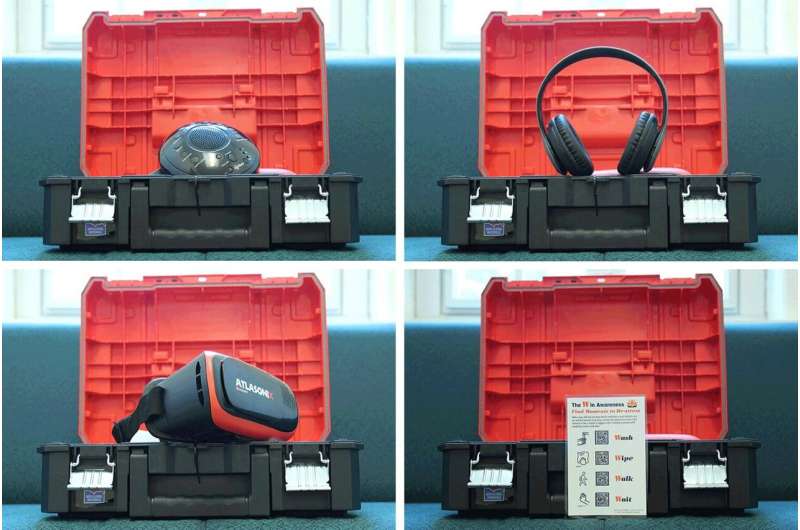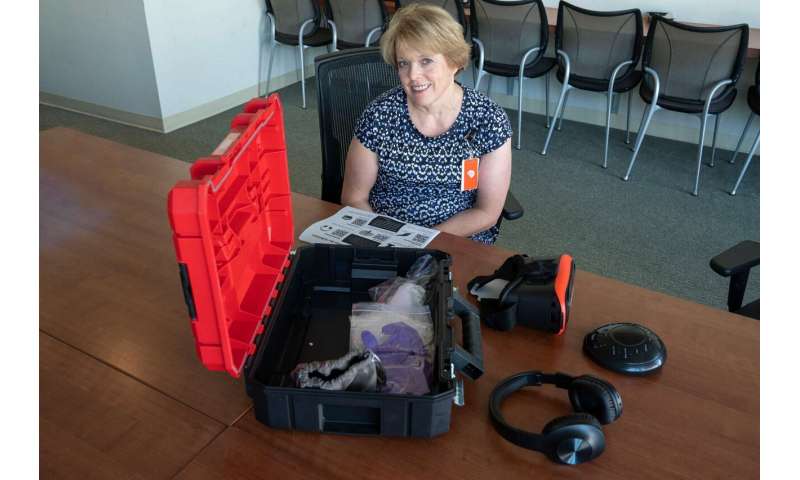'Room to reflect': A pilot workplace resiliency intervention for nurses

Adrienne Banavage, interim nurse manager in the infusion clinic at the University of Virginia's Emily Couric Cancer Center, is no stranger to mindfulness. But Banavage, who meditates regularly, said the immediacy and proximity of the "Room to Reflect" toolboxes deployed throughout UVA Health since 2021 make them a powerful resource for clinicians and augment the care they give.
And if Banavage and her colleagues initially tinkered with the toolboxes' sound machines andvirtual reality headsetsout of "gadget curiosity," the visualization exercises the toolbox also contains ultimately get the most use day-to-day.
"It's a full minute to go from the infusion clinic to the waiting area," Banavage explained, "so we encourage those exercises to kind of reset as we walk to get to our patients."
When the pandemic struck and hospital break rooms were unexpectedly repurposed due to a deluge of ill patients and COVID-19-related gear, a trio of UVA Health nurses put their heads together to find a different way for clinicians to take a breather during a shift. Now, two years later, the results of their "Room to Reflect" mobile toolboxes are in, and reveal the benefits of physical, on-unit reminders to take five.
It was mid-2021 when UVA Health nurses Nancy Farish, Jane Muir and Jeanell Webb-Jones deployed the toolboxes across seven hospital units, home to nearly five-dozen nurses and nurse managers, for a series of two-month trials. The bright red boxes—each containing sound machines, VR headsets and short guided mindfulness activities that nurses can do while they work or are between patients—were distributed across inpatient, outpatient, pre-operative and post-operative settings, and nurse managers on those units championed their use. Caregivers could access the resources both by using the toolboxes' contents and through QR, or quick-response, codes.
Participants' baseline resilience scores were assessed prior to using the intervention, and then again at the end of the study. They also answered open-ended questions about the toolboxes' impact, barriers encountered and their accessibility.
In all, 50 staff nurses and seven nurse managers were followed. While their mean resilience scores increased marginally in aggregate, the researchers saw more significant increases in resilience scores among more experienced nurses and nurse managers, who moved from the lowest resilience quartile to the second quartile—a promising result, Muir said, for health care organizations looking to implement the program. Nurse managers also reported that the intervention improved their RN staffs' stress management and job satisfaction.
The toolboxes' pocket guide with mindfulness prompts proved to be the most used intervention, followed by soothing audio and the VR headset, which featured calming nature videos. More than 85% of managers in the study encouraged staff verbally to take breaks but noted that the demands of patients with challenging medical conditions remained a significant barrier.
"The toolbox had a lot of traction when it first was rolled out," said Rebekah Melan, anursemanager on 6 East, where she oversees care of primarily orthopedic, urology and plastic surgery patients, "but one of the biggest barriers [to their continued use] has been time, and turnover of staff."

Over the two-month pilot, most nurses used the toolkits' contents between one and five times.
"Our findings establish that RNs are interested in and can use technology that efficiently helps them restore in the workplace," write the authors, who just published their findings in the InternationalJournal of Environmental Research in Public Health. "Resilience is a skill that can be learned."
Before the pandemic, burnout rates among nurses were already high. Today, as the pandemic enters its third year, up to 55% of nurses in the U.S. and around the world report burnout, and post-traumatic stress rates remain high.
For resilience programs to be effective, the authors say, several systemic factors must be addressed: adequate time and space for breaks, leaders who advocate for well-being, and tools that are quick, accessible, easy-to-use, and can be used during a shift, rather than accessed outside ofwork hours. The authors also insist that well-being activities must be part of hospitals' workflow and culture, rather than placed solely on the clinicians' shoulders—a sentiment with which Melan agreed.
"When you have leadership that is supportive of nurses taking mental health breaks when they need them," she said, "or provides more coverage to team members so they can have a break, we'll definitely have more buy-in."
护士报告较高的韧性less likely to be burned out, offer superior care, and cost hospital systems less because they make fewer errors. They are also less likely to leave the profession.
"A plethora of studies identify that resilience buffers the impact of occupational stress, reduces the risk of burnout, and enhancessocial connectionson the job," the authors write. "[R]egistered nurses seek resiliency practices not only for personal well-being, but professional development. Such findings have positive implications for the quality of patient care and delivery."
The toolboxes remain scattered throughout units at UVA Health, including in the quiet room where Banavage and her colleagues often go for breaks. Their proximity, she said, makes them powerful.
"The big thing for me is, especially during a difficult time, that the boxes are a resource that's right there," Banavage said. "These are excellent, evidence-based resources to help people in a format and location that's exactly what people need. Getting relief in that moment, to feel better in that moment, that's what the toolbox does."
Explore further

















